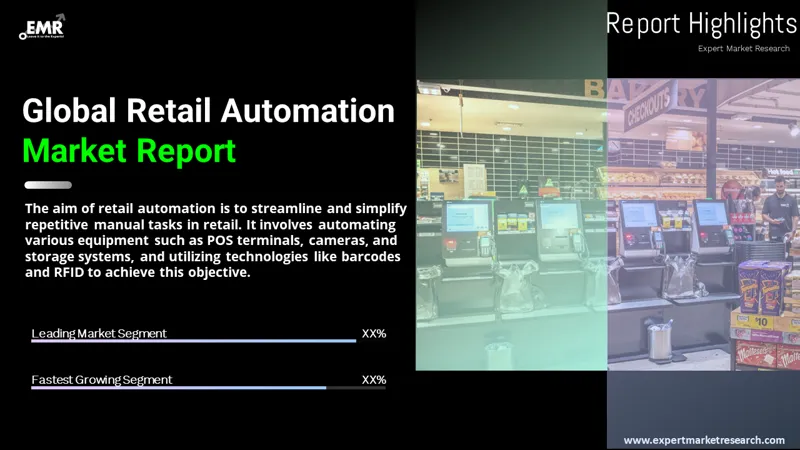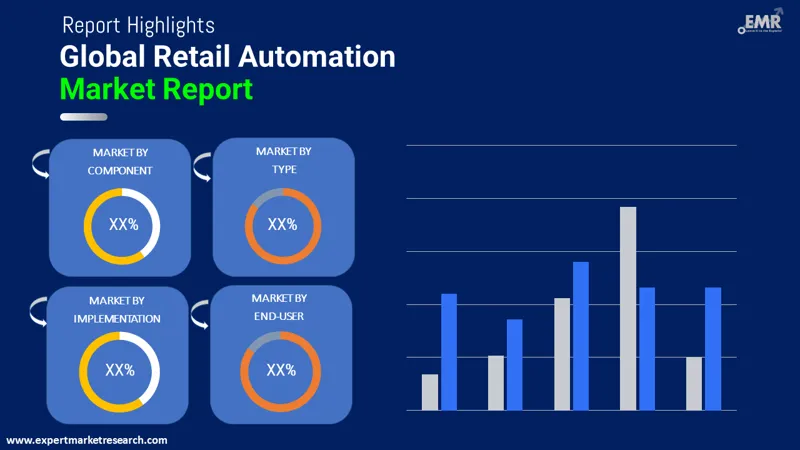
Consumer Insights
Uncover trends and behaviors shaping consumer choices today
Procurement Insights
Optimize your sourcing strategy with key market data
Industry Stats
Stay ahead with the latest trends and market analysis.
Trending Now



The global retail automation market size reached a value of nearly USD 20.52 Billion in 2024. The market is assessed to grow at a CAGR of 10.20% during the forecast period of 2025-2034 to attain around USD 54.20 Billion by 2034. Growing automation technologies, which automate the operational workflows and increase the efficiencies, are driving the retail automation market growth. Automation software is one of the key drivers of change in retail environments, repeatedly optimizing supply chains and integrating Internet of Things (IoT) and Machine Learning (ML) solutions. Through technologies—including point-of-sale (POS) systems, inventory management, and customer service—companies can automate all of these processes. Over 15000 stores are using these systems, thus demand for automation software is ever-growing resulting in an expanding market. The market for retail automation also promises wider patronage made clear by the better dependency on data and real-time insights streamlining the progress to older systems.
Base Year
Historical Year
Forecast Year
Retailers are actively adopting self-service kiosks for ordering, payment, and information access to cater to evolving customer preferences, attributed to their speed and convenience. A report by PYMNTS Intelligence, in collaboration with Discover Global Network, in 2024 revealed that 84% of consumers in the United States prefer self-service kiosks. Retailers are expected to adopt self-service kiosks to reduce labour costs and human errors and automate tasks such as payment and ordering in the forecast period.
There is a rising deployment of automation and AI to improve operational efficiency, reduce costs, and personalise marketing. Reportedly, 87% of retailers have deployed some form of AI or automation technology. The growing adoption of AI and automation among retailers is prompting companies to innovate their offerings, leading to the development of tailored solutions such as AI-powered predictive analytics and demand forecasting models.
Robotic solutions are becoming more mainstream in retail environments to improve accuracy, manage stock levels, ensure product availability, and monitor store environments. In 2023, inventory scanning robots operating on the BrainOS® platform captured more than 7.9 billion images.






Value in USD Billion
2025-2034
Retail Automation Market Outlook
*this image is indicative*
Read more about this report - REQUEST FREE SAMPLE COPY IN PDF
POS systems have continued to evolve towards cloud-based deployment models which enable retailers to scale their business vertically and horizontally significantly and in an agile manner. Especially in the ecommerce sphere, where convergence between offline and online is crucial. Advanced analytics, with cloud-based POS software, businesses can leverage advanced analytics such as payments, POS, loyalty features, to monitor sales, inventory, and customer behavior in real time. The rise of contactless payment systems has also driven the integration of loyalty incorporations into POS systems. These systems have become an indispensable tool in modern retail, allowing for smoother transactions and improving the overall customer journey in-out of the physical and online shopping venues.
Cloud-based POS systems are streamlining transaction processes, and robotics process automation (RPA) is supporting operational workflows through task automation. Advanced inventory scanning systems powered by robotics platforms like artificial intelligence (AI) and ML are changing logistics solutions that will eliminate stresses of inventory management. For example, autonomous systems are used more and more to sort and deliver vehicles in warehouses, resulting in reduced reliance on human labor. Moreover, manufacturing technologies are being integrated into retail operations to increase production capacity. The emergence of robotics AI software providers is driving the frontier in automation, allowing for smarter, more dynamic retail environments which balance customer interaction and inventory management.

Read more about this report - REQUEST FREE SAMPLE COPY IN PDF
Robotics automation and advanced automation technologies are emerging as the key trends in the retail automation market. Retail automation solutions reduce transaction time and increase efficiency by automating the retail transaction process. Companies such as Apple and Starbucks have been adopting touchscreen interfaces in their self-checkout systems and interactive kiosks to deliver a seamless customer experience. The use of credit or debit card payments in automated systems is also reducing checkout wait time and increasing customer satisfaction. As automation technologies evolve, it's only natural for retailers to use these solutions to improve store operations, from inventory to customer service, pushing the market towards a more efficient, tech-driven future.
As ecommerce continues to grow, the demand for robotic process automation associated with online retail transactions will largely be driving the trends within the retail automation market. To get the job done right, retail software providers increasingly support more advanced retail solutions that can fully integrate with warehouse and inventory management systems. Automated inventory management is another trend that is taking the lead, which aids retailers manage the stock levels in real-time. Robots are increasingly deployed in warehouses for sorting, packing and moving inventory, making operations more efficient. In-store, self-checkout systems are being rolled out in more and more brick-and-mortar stores to create a more meaningful customer experience with shorter waiting times. According to preliminary estimates, the percentage of people in industries including transportation equipment, primary metal, and plastic and rubber products who operate in establishments with robots was significant, surpassing 30%.
Increasing trend of self-checkouts; rising focus on sustainability and energy-efficiency; growing integration of AI and ML in retail automation; and technological advancements and innovations are shaping the retail automation market landscape.
The increasing number of self-checkout systems amid shifting consumer habits, labour shortages, and growing wage concerns is creating lucrative retail automation market opportunities. Benefits such as reduced wait times, seamless integration with loyalty programme, and improved employee efficiency offered by self-checkout systems are boosting their adoption in retail environments. 91% of retailers consider self-checkouts as a major factor contributing to higher sales, and they speed up the transaction process by 30%. In March 2024, Target announced the introduction of Express Self-Checkout for 10 items or less at almost 2,000 stores available during the busiest shopping times. Moreover, the development of mobile-based self-checkout solutions that enable customers to use smartphones to scan and pay for items and lower the need for physical self-checkout kiosks is expected to aid the market in the forecast period.
The rising awareness regarding sustainability and climate change is bolstering the retail automation market development. Retailers and technology providers are incorporating green practices and energy-efficient technologies into automated systems in order to reduce their environmental impact and cater to eco-conscious customers. There is a rising demand for automated lighting, HVAC, and refrigeration systems in retail environments to reduce energy consumption while maintaining product quality and ambient environments. Retailers are also adopting automated packaging solutions, recycling stations, and shelf-life management systems to optimise the usage of packaging materials, improve the recycling rate in-store, and reduce waste by adjusting product stock levels based on demand patterns.
Advancements in artificial intelligence (AI) and machine learning (ML) aimed at optimising operations, improving customer experiences, and driving efficiency across the value chain are shaping the retail automation market trends and dynamics. Reportedly, AI can unlock between USD 400 billion and USD 660 billion in economic value for the retail industry. Hence, retailers are extensively leveraging AI and ML to provide personalised recommendations to customers, recommend in-store positioning, and offer predictive shopping insights. Such technologies also reduce stockouts and overstocking and facilitate smart price optimisation based on factors like competitor pricing, demand, and inventory levels, increasing sales and margins. In September 2024, UST launched the UST Retail GenAI platform, a solution that enables businesses with end-to-end operational enhancements while delivering comprehensive tools to optimise every facet of retail operations.
Technological advancements and innovations are increasing the retail automation market value. The integration of IoT devices in retail to enable the automation of warehouses and stores, track product availability in real-time, empower businesses to connect products, equipment, and consumers, and optimise supply chains fuels the market. Retailers, especially in the fashion and beauty domains, are leveraging augmented reality (AR) and virtual reality (VR) to create virtual and immersive shopping experiences and facilitate virtual try-ons, reduce the need for physical trials, and support customers to rapidly make purchasing decisions. Such technologies also provide customers with interactive product visualisations, like 3D models, to improve their experiences.
Retail automation in-store is revolutionizing the customer experience with self-checkout systems, interactive kiosks, and advanced POS solutions. Retailers, in increasing numbers, seek a faster process that can utilize cloud-based POS systems to expedite transactions at a low cost, thus minimizing wait times, reducing the risk of queues, and providing fast, touchless checkout processes. The shift also is made easier through automated inventory management systems that track stock levels in real-time. Additionally, robots are also used to aid in-store, such as restocking the shelves and directing customers, resulting in a smoother, more dynamic retail experience.
Retail automation algorithms and systems are used in warehouses to streamline processes and increase operational efficiency, using robotics and automated inventory management systems. Robots are used for sorting, picking and packing inventory, saving labor costs and increasing output. Automated warehouse systems contribute to increased accuracy and speed, improving the efficiency of inventory management and reducing human error. By integrating ecommerce platforms, retailers can automatically receive real-time updates on their available stock, making sure they fulfill customers' orders accurately. With automation becoming a feature of the retail industry, these improvements in warehouse operations are key to the wider adoption of online retail transactions.
Point-of-Sale (POS) systems are now transforming cash registers into modern solutions that are faster and more secure. Features include real-time tracking and reporting that seamlessly integrates with inventory management. The latest POS systems also support both contactless payments and advanced customer loyalty features, offering enhanced customer experience and operational efficiency. These POS systems are being adopted by the retailers for ease of faster in-store transactions and for expedited checkout.
Meanwhile, due to their growing use in retail settings for a variety of tracking and logistics applications, the barcode and RFID segment is expected to grow significantly over the course of the projection period. Regular inventory checks are made simpler and more accurate by barcode and RFID technology, which also improves customer convenience and retailer administration. On the other hand, Electronic Shelf Labels (ESL) allow dynamic and instant updates of pricing and product information, thus improving the customer experience. The rise of AI powered cameras also align with retail automation. These are being deployed to help processes like surveillance, customer behavior analysis and loss prevention. Retailers are also deploying Autonomous Guided Vehicles (AGVs) in warehouse settings to move and guide goods efficiently. With the use of Automatic Storage and Retrieval Systems (ASRS) and warehouse robots, inventory is managed more effectively, hence there is reduced need for labor, and high output that can be achieved. Combined, these technologies result in improved operational efficiency, cost reduction, and better customer satisfaction in retail and warehouse settings.

Read more about this report - REQUEST FREE SAMPLE COPY IN PDF
Components of hardware are being increasingly used for the automation of retail stores like Point-of-Sale (POS) terminals, RFID scanners, electronic shelf labels, autonomous robots, and more. They are physical assets that can help to speed up the transaction, improve inventory tracking, and automate warehousing. Components like autonomous guided vehicles (AGVs) and automatic storage and retrieval systems (ASRS) make product handling more efficient, which ultimately results in positive relationships with customers.
Retail automation software integrates different hardware components and optimizes the operations. That includes cloud-based POS systems that simplify retail transactions and sophisticated analytics platforms that monitor sales, inventory and customer behavior. Real-time data syncing is now possible with RFID and barcode management software and inventory management and warehouse automation software. Robust software systems help retailers stock appropriately, avoid errors, and also help improve the shopping experience overall.
Retail automation solutions are increasingly being used in hypermarkets to simplify larger-scale operations. Automated inventory management systems are being integrated with point-of-sale (POS) systems for real-time stock tracking. Self-checkout systems are often used to decrease the checkout time and enhance customer experience. Technological advancements like robotics and automated sorting systems in warehouses streamline stock movement and aid in the handling of high volumes of products.
Further, automation allows supermarkets to automate their inventory management and ensure that prices are accurate, and stock is available through RFID systems and electronic shelf labels. Automation also helps single-item stores, like convenience stores, facilitate transactions and manage a narrow range of goods. Fuel pumps and fuel stations are embracing automation to handle fuel transactions, inventory, and customer loyalty programs. In health and retail pharmacies, automation can assist and manage stock levels, process prescriptions and offer a seamless checkout experience. From automating processes to minimizing human error and improving the overall efficiency of their operations and customer service, these industries are rapidly embracing automation technologies to facilitate the smooth functioning of a variety of retail sectors.
North America Retail Automation Market Insights
North America has led the introduction of retail automation solutions due to the uptake in robotics, AI and cloud-based point-of-sale (POS) systems. In addition, United States and Canadian retailers are starting to implement automated solutions to increase operational efficiency and enhance the shopping experience. Especially for big retail chains the demand for self–checkout systems, inventory management solutions and automatic towers systems is increasing with great number. Meanwhile, North America remains a key market for retail automation owing to the increasing efforts to enhance efficiency and reduce operational costs, with large investments from established retailers as well as tech companies.
Asia Pacific Retail Automation Market Insights
The ecommerce sector is growing exponentially across Asia Pacific, with consumer demand for seamless shopping driving significant adoption of retail automation. China, Japan, and India are among the nations, leading the charge to new technologies, including robotics, RFID, and cloud-based POS systems. Regional retail offering varies from hypermarkets and supermarkets to single-item stores, which is increasing the need for automation to manage inventory, improve customer service and optimize supply chains. AI and machine learning are being integrated into automation solutions enhancing productivity and offering a more personalized shopping experience in this dynamic region.
Europe Retail Automation Market Insights
Retail automation comprises industrial operations in many European regions that heavily focus on improving operational efficiency and customer engagement. To improve the shopping experience, they are implementing solutions such as cloud-based POS systems, automated inventory management, and self-checkout technologies. The market observes rising demand for automated solutions in retail pharmacy, supermarkets and hypermarkets. They are also seeking sustainable solutions like automation technologies that play a key role in reducing waste and enhancing resource management within retail operations.
Latin America Retail Automation Market Insights
Retail automation is on the increase in Latin America as Brazilian and Mexican retailers are adopting automated solutions to respond to increase in demand and the resultant operational pressure. Cloud POS systems and automated stock management are allowing companies to become more efficient and responsive to customers' demands. Automating those aspects is becoming an appealing investment, especially for the Latin American retailers by reducing operational costs and increasing accuracy on stock management. Although the adoption rate is still short of that of the United States, great advancements in automation are expected in Latin America’s retail industry.
The retail automation market is highly competitive, due to the presence of many established key players. Leading companies are focused on delivering operational excellence, crafting customer experience, and rolling out advanced automation solutions such as robotics, AI-driven POS systems, and cloud-based inventory management. The market is expanding at a rapid pace as retailers adopt automation to enhance efficiencies.
Datalogic S.p.A., with its headquarters in Bologna, Italy, is a global technology leader in automatic data capture and factory automation. The company, which was established in 1972, specialises in the development and manufacture of barcode readers, measurement and detection, RFID, portable computers, sensors for safety, and vision and laser marking systems.
Diebold Nixdorf Inc., based out of Ohio in the United States and founded in 1859, provides software, hardware, and information technology services. The company offers integrated mobile point of sale (POS) systems, physical security devices, intelligent deposit terminals, teller automation tools, and cash recyclers and dispensers. Diebold provides services including installation, maintenance, support, and value-added services.
Posiflex Technology Inc., headquartered in Taipei, Taiwan, and established in 1984, is a world leader in the development and production of OEM/ODM solutions for PCs, peripherals, and Point of Sale (POS) management systems. The POS systems from Posiflex are available in a variety of configurations and capabilities so as to suit the needs of various clients.
*Please note that this is only a partial list; the complete list of key players is available in the full report. Additionally, the list of key players can be customized to better suit your needs.*
The study on the retail automation market delivers detailed analysis on region-level perspective depending on specific contemporary industry trends. It considers various segments, such as implementation, product, component and end use. By assessing all these segments, this report presents a thorough discussion of market drivers, regulations, and emerging opportunities observed in the market.
Component Outlook (Revenue, Billion, 2025-2034)
Product Outlook (Revenue, Billion, 2025-2034)
Implementation Outlook (Revenue, Billion, 2025-2034)
End Use Outlook (Revenue, Billion, 2025-2034)
Region Outlook (Revenue, Billion, 2025-2034)
*While we strive to always give you current and accurate information, the numbers depicted on the website are indicative and may differ from the actual numbers in the main report. At Expert Market Research, we aim to bring you the latest insights and trends in the market. Using our analyses and forecasts, stakeholders can understand the market dynamics, navigate challenges, and capitalize on opportunities to make data-driven strategic decisions.*
Get in touch with us for a customized solution tailored to your unique requirements and save upto 35%!
In 2024, the market reached an approximate value of USD 20.52 Billion.
The retail automation market is assessed to grow at a CAGR of 10.20% between 2025 and 2034.
The market is estimated to witness to reach a value of around USD 54.20 Billion by 2034.
The major factors driving the market growth include the growing awareness and popularity of retail automation, rising adoption of automation technologies by major retailers, and increasing penetration of the Internet of Things (IoT).
The rising demand for quality and fast service by retail buyers, increasing adoption of digital payments, growing competition among retailers are the key trends propelling the growth of the market.
The major regions in the market are North America, Europe, the Asia Pacific, Latin America, and the Middle East and Africa.
The advantages of automating retail include time and money savings, more employee productivity, improved customer experience, higher sales statistics, and a decrease in errors.
The different types of retail automation in the market are POS terminal, barcode and RFID, electronic shelf label, camera, autonomous guided vehicle (AGV), and automatic storage and retrieval system (ASRS), among others.
The significant components of the market for retail automation are hardware and software.
The major players in the retail automation market are Datalogic S.p.A., Diebold Nixdorf Inc., Fujitsu Ltd., Honeywell International Inc., NCR Corporation, Posiflex Technology Inc., Toshiba Global Commerce Solutions, Zebra Technologies Corp., SpotOn Transact, LLC, RapidPricer, 6 River Systems LLC, Amazon Web Services, Inc., Casio Computer Co. Ltd., E&K, Automation GmbH, ECR Software Corporation, Kiosk & Display LLC, Kuka AG, Pricer AB, and Wincor Nixdorf AG, among others.
North America accounted for the largest market share, as per the report.
Hypermarkets and supermarkets are expected to grow at the highest CAGR during the forecast period.
Explore our key highlights of the report and gain a concise overview of key findings, trends, and actionable insights that will empower your strategic decisions.
| REPORT FEATURES | DETAILS |
| Base Year | 2024 |
| Historical Period | 2018-2024 |
| Forecast Period | 2025-2034 |
| Scope of the Report |
Historical and Forecast Trends, Industry Drivers and Constraints, Historical and Forecast Market Analysis by Segment:
|
| Breakup by Component |
|
| Breakup by Product |
|
| Breakup by Implementation |
|
| Breakup by End Use |
|
| Breakup by Region |
|
| Market Dynamics |
|
| Competitive Landscape |
|
| Companies Covered |
|
Datasheet
One User
USD 2,499
USD 2,249
tax inclusive*
Single User License
One User
USD 3,999
USD 3,599
tax inclusive*
Five User License
Five User
USD 4,999
USD 4,249
tax inclusive*
Corporate License
Unlimited Users
USD 5,999
USD 5,099
tax inclusive*
*Please note that the prices mentioned below are starting prices for each bundle type. Kindly contact our team for further details.*
Flash Bundle
Small Business Bundle
Growth Bundle
Enterprise Bundle
*Please note that the prices mentioned below are starting prices for each bundle type. Kindly contact our team for further details.*
Flash Bundle
Number of Reports: 3
20%
tax inclusive*
Small Business Bundle
Number of Reports: 5
25%
tax inclusive*
Growth Bundle
Number of Reports: 8
30%
tax inclusive*
Enterprise Bundle
Number of Reports: 10
35%
tax inclusive*
How To Order
Our step-by-step guide will help you select, purchase, and access your reports swiftly, ensuring you get the information that drives your decisions, right when you need it.

Select License Type
Choose the right license for your needs and access rights.

Click on ‘Buy Now’
Add the report to your cart with one click and proceed to register.

Select Mode of Payment
Choose a payment option for a secure checkout. You will be redirected accordingly.
Gain insights to stay ahead and seize opportunities.

Get insights & trends for a competitive edge.

Track prices with detailed trend reports.

Analyse trade data for supply chain insights.

Leverage cost reports for smart savings

Enhance supply chain with partnerships.

Connect For More Information
Our expert team of analysts will offer full support and resolve any queries regarding the report, before and after the purchase.
Our expert team of analysts will offer full support and resolve any queries regarding the report, before and after the purchase.
We employ meticulous research methods, blending advanced analytics and expert insights to deliver accurate, actionable industry intelligence, staying ahead of competitors.
Our skilled analysts offer unparalleled competitive advantage with detailed insights on current and emerging markets, ensuring your strategic edge.
We offer an in-depth yet simplified presentation of industry insights and analysis to meet your specific requirements effectively.



Australia
63 Fiona Drive, Tamworth, NSW
+61-448-061-727
India
C130 Sector 2 Noida, Uttar Pradesh 201301
+91-723-689-1189
Philippines
40th Floor, PBCom Tower, 6795 Ayala Avenue Cor V.A Rufino St. Makati City,1226.
+63-287-899-028, +63-967-048-3306
United Kingdom
6 Gardner Place, Becketts Close, Feltham TW14 0BX, Greater London
+44-753-713-2163
United States
30 North Gould Street, Sheridan, WY 82801
+1-415-325-5166
Vietnam
193/26/4 St.no.6, Ward Binh Hung Hoa, Binh Tan District, Ho Chi Minh City
+84-865-399-124
United States (Head Office)
30 North Gould Street, Sheridan, WY 82801
+1-415-325-5166
Australia
63 Fiona Drive, Tamworth, NSW
+61-448-061-727
India
C130 Sector 2 Noida, Uttar Pradesh 201301
+91-723-689-1189
Philippines
40th Floor, PBCom Tower, 6795 Ayala Avenue Cor V.A Rufino St. Makati City, 1226.
+63-287-899-028, +63-967-048-3306
United Kingdom
6 Gardner Place, Becketts Close, Feltham TW14 0BX, Greater London
+44-753-713-2163
Vietnam
193/26/4 St.no.6, Ward Binh Hung Hoa, Binh Tan District, Ho Chi Minh City
+84-865-399-124
Share